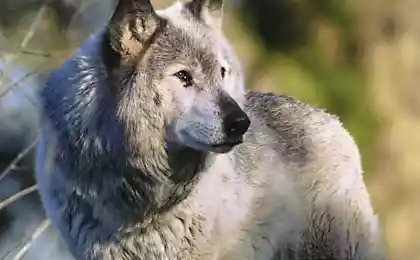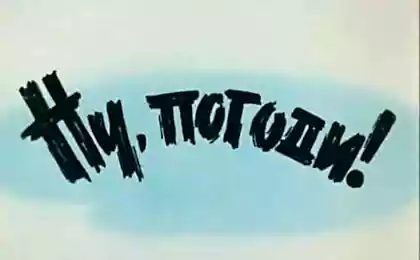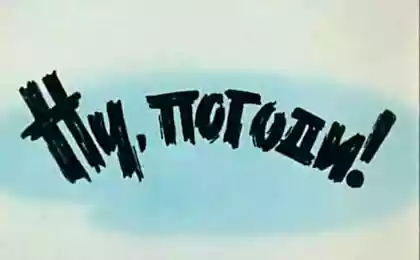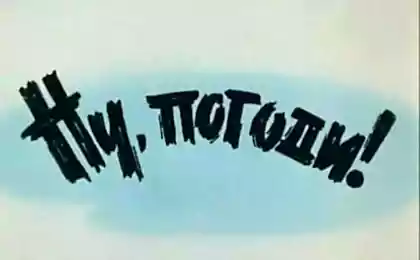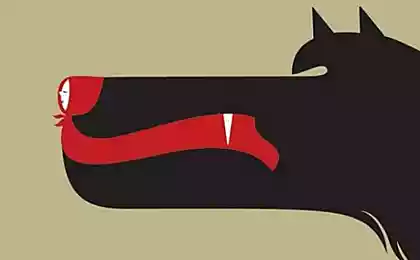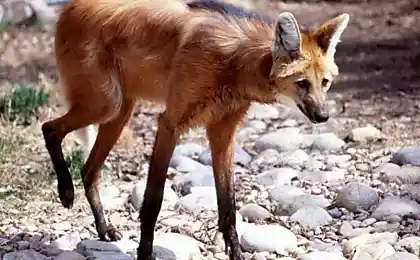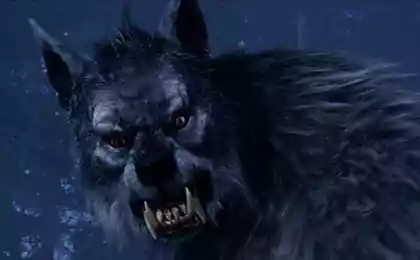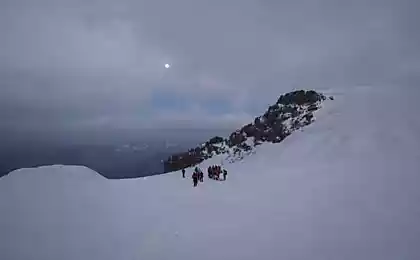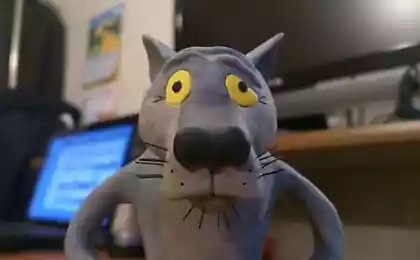985
Dramatic rescue of a wolf
Wolf, Navarre called it, was rescued from the icy waters of the river Limentra in the province of Bologna, Italy. Wolf was found severely malnourished, with paralysis of the hind limbs, and 35 lead bullets in the body. It was Monday, January 9, 2012. At 13:30 of the provincial police Montorio (Bologna, Italy) called in the department of animal rescue, Research Center for the Study of Exotic and Wild Fauna «Monte Adone», (hereinafter - "the Centre") . Police reported wounded wolf found in the Municipality of Camugnano (province of Bologna, Italy), and was asked to assist in his recovery. Traditionally, the rescue service works closely with the police, so the operation was carried out jointly.
Four staff members of the Centre (Rudi Berti, Elisa Berti, Gaia Ferrara, Lara Vassena) with veterinarian Dr. Marzia Naldi, immediately went to the place of discovery in two cars with all necessary equipment (cages for, stretchers, oxygen, a rifle with a tranquilizer, a first aid kit , etc...). Meanwhile, a local veterinarian Porretta Terme, with Dr. Alberto Tovoli (which also previously contacted), arrived on the scene detection wounded wolf, they went there immediately, and waited for rescuers, along with provincial police and a citizen who found the animal.
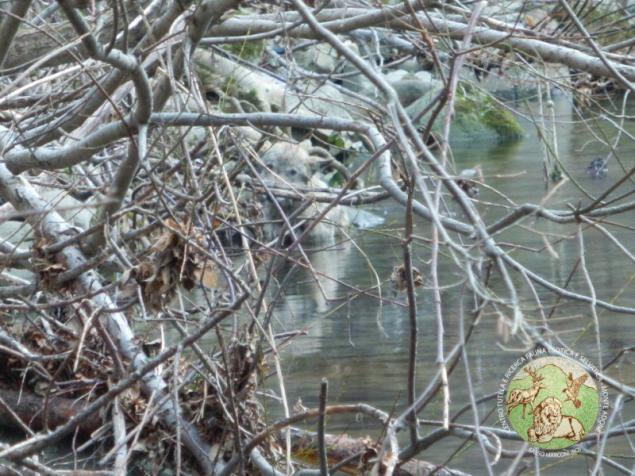
After passing 60 km rescuers arrived at the scene: the wolf - an adult male, was in the icy water of the river Limentra, close to shore. The animal was hungry, in a state of shock, and obviously the frozen due to prolonged stay in cold water. In addition, the hind legs were visible open wounds.
After a thorough analysis and assessment of the situation, the risks associated with the condition of the animal, the veterinarian Rudi Berti, (Director of the Center), lulled wolf, shooting a tranquilizer from a pneumatic gun. After being shot in the shoulder (the only part of the body apart from the head, which could be seen from the water), the wolf, trying to sail to the center of the river where the current was stronger. Without losing sight of the animal rescuers ran along the riverbank, getting ready to pull out of the wolf, which gradually lost consciousness under the influence of sleeping pills.
Taking advantage of the narrowing of the river, Elisa Berti, accompanied by other volunteers, she jumped into the water and managed to grab it. Despite considerable difficulties because of the strong currents and extremely slippery bottom of the channel, the three rescuers Center carried the wolf on the shore.
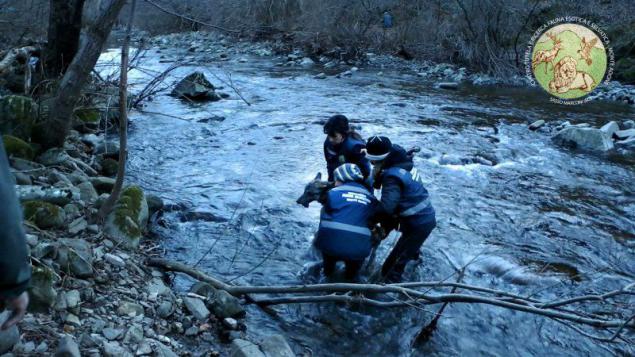
After inspecting the wolf veterinarians determined cardiopulmonary shock (cardiac arrest), his condition was critical.
Without delay, Dr. Elisa Berti Tovoli and started doing chest compressions and artificial respiration mouth-to-mouth. After several minutes of cardiopulmonary resuscitation, to everyone's delight, wolf resumed regular cardiac and respiratory activity. He was placed on a stretcher and under an oxygen mask during transport.
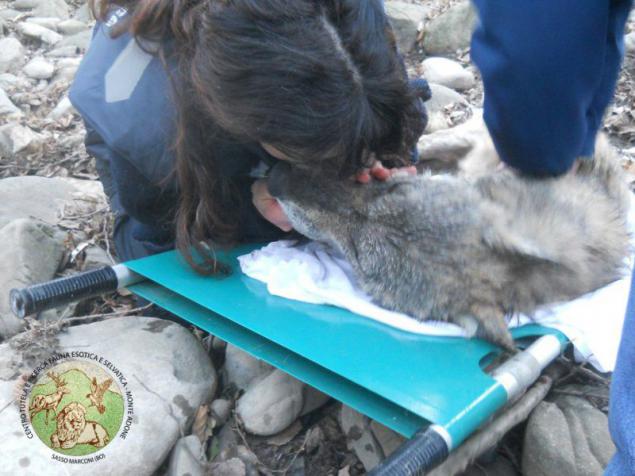
The next few hours, though still in a state of hypothermia, wolf slowly came to himself, letting his rescuers for the first time since the start of the rescue operation, to smile.
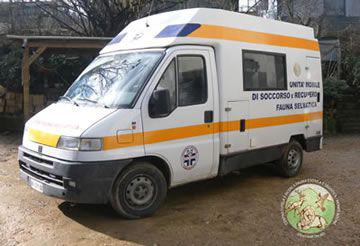
Upon arrival at the Center for the animal was in extreme agitation, to an extraordinary degree of exhaustion and dehydration, examination revealed paraparesis (paralysis) of the hind limbs. In addition, he suffered from extensive and widespread dermatitis - big bald spots, probably caused by scabies.
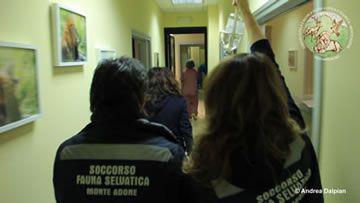
Initial blood tests showed the presence of infection and liver disease. X-ray examination showed the presence of the body in about 35 pieces of 4-millimeter bullets, distributed throughout the body, fractures were found. The animal shot with buckshot, very long time, fortunately it did not cause serious internal damage.
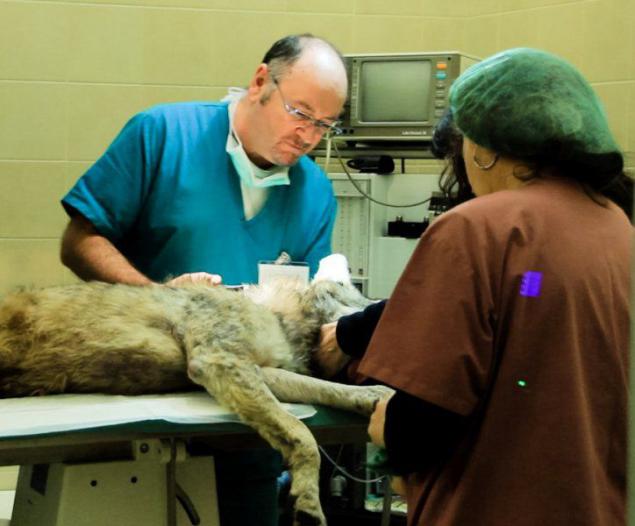
The first few days were very important for the condition of the animal. It was necessary to keep him in intensive care and watch him day and night. There have been many diagnostic and laboratory tests, which are immediately highlighted several problems.
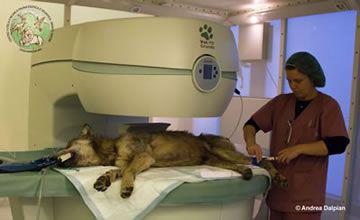
Since studies conducted have not identified the cause of the paralysis of the hind legs, it was decided to continue the search. With the permission of the competent authorities, on 12 January, the Center, accompanied by a veterinary surgeon Dr. Giulio Masiello, the wolf was transported to a veterinary hospital San Michele di Tavazzano Villavesco (province of Lodi), where Dr. Offer Zeira, a neurologist who works with the Center for many years, along with other studies, he decided to expose him to magnetic resonance imaging.

Dr. Zeira and his highly trained staff dedicated themselves to this incredible animal with professionalism and selflessness, and they succeeded in accurate diagnosis of pathology wolf. Magnetic resonance imaging showed the presence of deforming spondylosis between the 4th and 5th thoracic vertebra - pyoinflammatory formation that affects the intervertebral disc and surrounding tissue. This led to the brain and spinal cord compression caused paraparesis of the hind limbs.
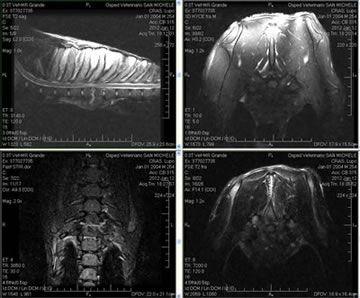
In the most delicate - the initial stage of recovery, wolf weekly examined Dr. Renato Magliulo conducting ozone therapy, and Dr. Donatella Zambelli did acupuncture.
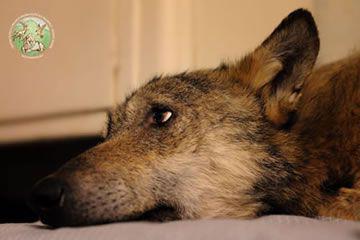
Blood samples were taken to the laboratory of the Institute of Genetics, Nature Protection and Environmental Research (ISPRA), which carried out the necessary genetic studies. Blood tests did Dr. Naldi, they are often repeated to monitor the slightest changes in the status of the animal. Analysis shows the progress and improvement of all parameters.

Full recovery of the wolf Navarre required a certain rehabilitation programs. From the date of his arrival, taking care of the animals was carried out 24 hours a day. Without losing the pride and strength of spirit which distinguish its form, Navarre patiently agree to inspections and procedures, and day after day showed strong character and desire to live.

(Photos Alberto Tovoli and Paul Taranto)
--img13--
He scored 5 kg of weight, get rid of scabies and hair gradually grow; Numerous diseases (intestinal infection, heart, uro-genital) - and the other, almost completely healed.
Yet there are consequences of heavy defeat of the hind limbs and muscular atrophy, but the greatest satisfaction - is to see how he goes again, going through all the long distance. He was hard, though Navarre has not yet shown the full ownership of the limbs and there is confidence in the movements, the necessary condition to be considered complete his recovery and the possibility of release into the wild. It is found in as close to the wild environment, in an environment that will allow him best to prepare yourself for a new life.
--img14--
From a psychological point of view, Navarre regains the typical behavior of a predator of its kind, featuring a progressive dynamics also in this aspect.
--img15--
Source: www.centrotutelafauna.org
Four staff members of the Centre (Rudi Berti, Elisa Berti, Gaia Ferrara, Lara Vassena) with veterinarian Dr. Marzia Naldi, immediately went to the place of discovery in two cars with all necessary equipment (cages for, stretchers, oxygen, a rifle with a tranquilizer, a first aid kit , etc...). Meanwhile, a local veterinarian Porretta Terme, with Dr. Alberto Tovoli (which also previously contacted), arrived on the scene detection wounded wolf, they went there immediately, and waited for rescuers, along with provincial police and a citizen who found the animal.

After passing 60 km rescuers arrived at the scene: the wolf - an adult male, was in the icy water of the river Limentra, close to shore. The animal was hungry, in a state of shock, and obviously the frozen due to prolonged stay in cold water. In addition, the hind legs were visible open wounds.
After a thorough analysis and assessment of the situation, the risks associated with the condition of the animal, the veterinarian Rudi Berti, (Director of the Center), lulled wolf, shooting a tranquilizer from a pneumatic gun. After being shot in the shoulder (the only part of the body apart from the head, which could be seen from the water), the wolf, trying to sail to the center of the river where the current was stronger. Without losing sight of the animal rescuers ran along the riverbank, getting ready to pull out of the wolf, which gradually lost consciousness under the influence of sleeping pills.
Taking advantage of the narrowing of the river, Elisa Berti, accompanied by other volunteers, she jumped into the water and managed to grab it. Despite considerable difficulties because of the strong currents and extremely slippery bottom of the channel, the three rescuers Center carried the wolf on the shore.

After inspecting the wolf veterinarians determined cardiopulmonary shock (cardiac arrest), his condition was critical.
Without delay, Dr. Elisa Berti Tovoli and started doing chest compressions and artificial respiration mouth-to-mouth. After several minutes of cardiopulmonary resuscitation, to everyone's delight, wolf resumed regular cardiac and respiratory activity. He was placed on a stretcher and under an oxygen mask during transport.

The next few hours, though still in a state of hypothermia, wolf slowly came to himself, letting his rescuers for the first time since the start of the rescue operation, to smile.

Upon arrival at the Center for the animal was in extreme agitation, to an extraordinary degree of exhaustion and dehydration, examination revealed paraparesis (paralysis) of the hind limbs. In addition, he suffered from extensive and widespread dermatitis - big bald spots, probably caused by scabies.

Initial blood tests showed the presence of infection and liver disease. X-ray examination showed the presence of the body in about 35 pieces of 4-millimeter bullets, distributed throughout the body, fractures were found. The animal shot with buckshot, very long time, fortunately it did not cause serious internal damage.

The first few days were very important for the condition of the animal. It was necessary to keep him in intensive care and watch him day and night. There have been many diagnostic and laboratory tests, which are immediately highlighted several problems.

Since studies conducted have not identified the cause of the paralysis of the hind legs, it was decided to continue the search. With the permission of the competent authorities, on 12 January, the Center, accompanied by a veterinary surgeon Dr. Giulio Masiello, the wolf was transported to a veterinary hospital San Michele di Tavazzano Villavesco (province of Lodi), where Dr. Offer Zeira, a neurologist who works with the Center for many years, along with other studies, he decided to expose him to magnetic resonance imaging.

Dr. Zeira and his highly trained staff dedicated themselves to this incredible animal with professionalism and selflessness, and they succeeded in accurate diagnosis of pathology wolf. Magnetic resonance imaging showed the presence of deforming spondylosis between the 4th and 5th thoracic vertebra - pyoinflammatory formation that affects the intervertebral disc and surrounding tissue. This led to the brain and spinal cord compression caused paraparesis of the hind limbs.

In the most delicate - the initial stage of recovery, wolf weekly examined Dr. Renato Magliulo conducting ozone therapy, and Dr. Donatella Zambelli did acupuncture.

Blood samples were taken to the laboratory of the Institute of Genetics, Nature Protection and Environmental Research (ISPRA), which carried out the necessary genetic studies. Blood tests did Dr. Naldi, they are often repeated to monitor the slightest changes in the status of the animal. Analysis shows the progress and improvement of all parameters.

Full recovery of the wolf Navarre required a certain rehabilitation programs. From the date of his arrival, taking care of the animals was carried out 24 hours a day. Without losing the pride and strength of spirit which distinguish its form, Navarre patiently agree to inspections and procedures, and day after day showed strong character and desire to live.

(Photos Alberto Tovoli and Paul Taranto)
--img13--
He scored 5 kg of weight, get rid of scabies and hair gradually grow; Numerous diseases (intestinal infection, heart, uro-genital) - and the other, almost completely healed.
Yet there are consequences of heavy defeat of the hind limbs and muscular atrophy, but the greatest satisfaction - is to see how he goes again, going through all the long distance. He was hard, though Navarre has not yet shown the full ownership of the limbs and there is confidence in the movements, the necessary condition to be considered complete his recovery and the possibility of release into the wild. It is found in as close to the wild environment, in an environment that will allow him best to prepare yourself for a new life.
--img14--
From a psychological point of view, Navarre regains the typical behavior of a predator of its kind, featuring a progressive dynamics also in this aspect.
--img15--
Source: www.centrotutelafauna.org


